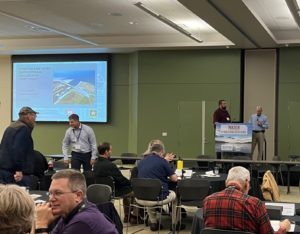Missouri State University and the Tri-State Water Resource Coalition hosted the Water: Establishing Resilience conference at Darr Agricultural Center on Tuesday, November 1st. Roddy Rogers, Executive Director of Southwest Missouri Water (SWMO), hosted the event.
To open, Roddy established the importance of attendees’ efforts, mentioning how a single “water job” generates 3.98 other jobs. He stressed how each entity has an important decision to make as we move forward in active drought mitigation, “The train is not leaving the station yet, but we’ll all have to decide if we are buying the ticket or not.”

Harold Bench was awarded Water Warrior Extraordinaire! Born in 1935, Harold has spent his life as a steward of our waterways. When accepting his award, Harold stressed the importance of supporting future visionaries to sustain our resources. He shared his first-hand experience with drought externalities, such as a plague of grasshoppers from farming as a child.
Hydrologist Alex Pivarnik with the U.S. Bureau of Reclamation in the Colorado Basin discussed water management in the West during drought. Their operation is the nation’s largest water wholesaler and is considered the Water Master of the lower Colorado River. Serving 17 states, it brings water to the people and helps produce 60% of the nation’s fruits and 25% of its nuts.
The Bureau participates in multiple activities to manage the watersheds:
- Develop Annual Operating Plan
- Schedule Water Releases from Hoover, Davis, and Parker Dams
- Administer water contracts and approve U.S. water orders
- Account for all water use:
- Provide flood control and river regulation
- Meet water delivery and salinity requirements under the 1944 US-Mexico water treaty and minutes
- Generate hydropower
- Implement LCR multi-species conservation program
- Support recreational opportunities
In discussing the future of water out West, Alex spoke of the 500 Plus Plan, which targets a million acre-feet of conservation in 2022 & 2023. This would help avoid and protect against rapid elevation decline in Lake Mead and encourage water Conservation efforts such as ICS. Learn more about ICS here.
To follow, featured speaker Elizabeth Kerby with the Missouri Department of Natural Resources discussed Missouri’s Drought Planning. Elizabeth opened by establishing the importance of drought mitigation to our state. As we are among the country’s top agricultural producers, we must be aware of drought impacts and possibilities.
Elizabeth discussed how the state assesses vulnerability to drought and prioritizes action with consideration of the history of Drought in Missouri, “Based on analysis of historical and projected future PDSI trends, the Northeast, North Central, and West Decentral crop reporting districts are more likely to experience drought relative to other districts.”

When assessing Drought Resilience, DNR considers the following:
- Ease of accessing alternative sources of water
- Interconnections of waterways
- Social vulnerability
The 2022 Missouri Drought Mitigation and Response Plan comprise eight components and a matrix of over 100 mitigation and response actions and strategies. These include regional-specific actions at the state and local levels, which are identified based on their ability to reduce impacts, lower susceptibility, or improve resilience.
 Next, the Corps of Engineers offered an update on SWMO Water Reallocation. They discussed long-term initiatives to enhance and widen the water supply distribution through the Stockton Lake Water Supply Storage Reallocation Study Update.
Next, the Corps of Engineers offered an update on SWMO Water Reallocation. They discussed long-term initiatives to enhance and widen the water supply distribution through the Stockton Lake Water Supply Storage Reallocation Study Update.
Learn more about the conference and the future of our watersheds here.

